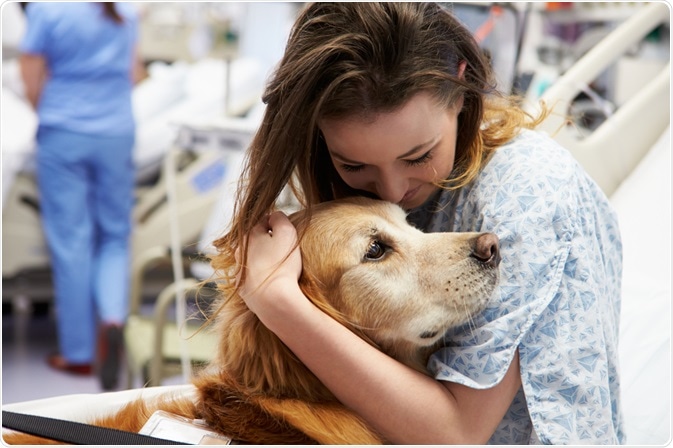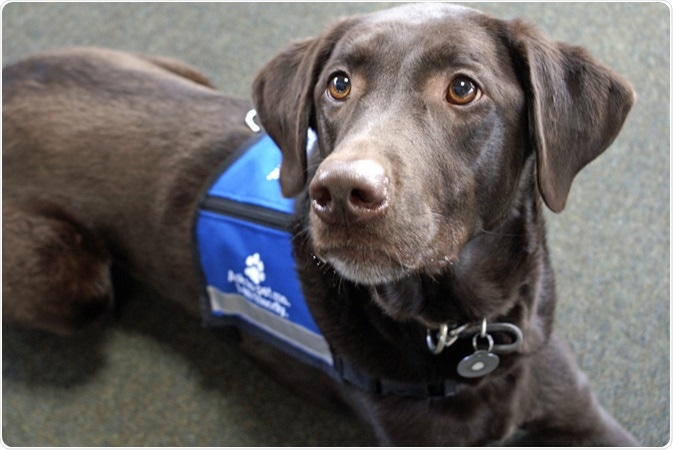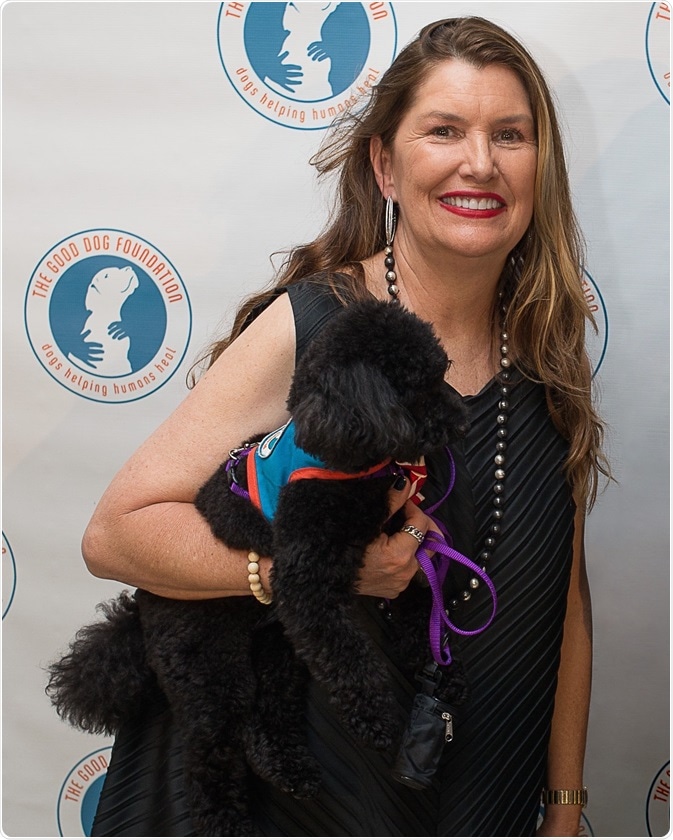Since founding Good Dog 20 years ago, our organization has had a singular mission – helping humans heal from the trauma of disease, disability and disaster. Our healers are pets – namely, dogs – and their human handlers. They volunteer. And we transform them into skilled certified therapy dog teams. But first, they must apply and be admitted to one of our training-certification classes.
Good Dog committed from the start to being a science-driven organization. The effects of animal therapy on stress reduction and emotional well-being are strong but need to be well documented in unbiased scientific literature to help support a professional approach to the field.

Shutterstock | Monkey Business Images
As a good example, around eight or nine years ago we received a sizable grant from Pfizer’s animal health care unit, Zoetis, to underwrite a cancer study. We chose to partner with Beth Israel / Mount Sinai Medical Center in New York. Our study’s Principal Investigator, Dr. Stewart Fleishman, a cancer care specialist, wanted to explore whether or not therapy dogs could help patients cope with treatment for advanced throat and neck cancers.
The treatment regimen, combined radiation and chemotherapy, is effective but brutal, causing patients to deteriorate physically and emotionally, sometimes to the point where some patients don’t want to continue.
What we found, over several years of the study, was that patients who were visited by one of our therapy dog teams for 15 minutes during each treatment not only stopped deteriorating emotionally – their emotional and social wellbeing improved versus the control group who were not visited by our dogs.
Elaine + Zoey and the Bendheim Cancer Center at Greenwich Hospital
The study results were published in the peer-reviewed Journal of Community and Supportive Oncology and got enormous coverage. As a consequence, Good Dog was invited to a two-day global summit hosted by the National Institute of Child Health and Human Development . There, we met healthcare providers doing extraordinary research on Animal Assisted Therapy (AAT). They encouraged us to play a bigger role in helping the academic and scientific community build a solid evidence base for the AAT field.
Please describe your recent research that investigates the human-animal bond.
Shortly after returning from the NIH summit in the spring of 2015, we were approached by both Yale University and Pace University.
We worked with Yale’s Innovative Interactions Lab for two years on a study to assess three different methods for helping children recover from stress: time out, a tactile blanket, or unstructured time with a therapy dog. We helped establish the study protocols that were designed to isolate out the treatment effects of dogs while prioritizing both human and dog safety and welfare. We also provided certified therapy teams who participated.
The study spotlighted two important findings: (1) dogs, all by themselves, can improve children’s mood and ability to cope with anxiety, and (2) they can do so as a therapeutic intervention for stress recovery. This is the first study to look at the impact of dogs on stress recovery in children.
Its finding, that “interactions with animals represent a promising way to reduce the burden of childhood mental illness on a large scale,” is of enormous potential consequence. It was published in the peer-reviewed Journal of Clinical Child & Adolescent Psychology and titled, “The Influence of Interactions with Dogs on Affect, Anxiety, and Arousal in Children.”
With Pace University, we are partners with their Department of Criminal Justice in designing and implementing a pilot study of female prisoners struggling to learn parenting skills prior to reunification with minor children.
Parenting, Prison, & Pups
Some 70% of female inmates in the U.S. leave minor kids behind when incarcerated, and this severs and wounds the mother-child bond. Female inmates have a tougher time than males in jail, and their kids are an at-risk population, far more likely to end up in jail.
Our study, ‘Parenting, Prison, and Pups’ is now in its third year and already spotlighting the power of dogs to comfort prisoners and enhance learning. We’re hoping results show a positive, cost-effective scalable option for rehabilitating prisoners, especially those with children.
We have also been working with the University of Pennsylvania on the first-ever national survey of therapy dog training methods – a first step in developing a catalog of best practices and national standards. We are big advocates for national standards in this field.
How are the therapy dogs trained? Please describe the Good Dog Training and Certification Program.
Good Dog volunteer teams (human and canine) are carefully selected for training from a large pool of applicants. First, they have to fill out a lengthy online application, which asks questions about a dog’s overall temperament and health, how they react to loud noises, whether or not they’ve been exposed to children, if they have any history of aggression, and what their training history is.

Shutterstock | Shine Caramia
Applicants chosen for an evaluation must indicate on their application that the dog has a solid temperament, no history of aggression, and is well-versed in all basic obedience commands.
Teams that pass the online application are then evaluated in person by an expert trainer-evaluator to see if a dog is appropriate for therapy dog class. This evaluation is similar to the AKC Canine Good Citizen test, but a bit more rigorous.
We test the dogs to make sure they have obedience skills in place, can walk politely on a slack leash, do not vocalize inappropriately, and do not jump to greet people. They are also tested with strangers, loud noises, other dogs, and people (the evaluator) behaving in a manner that could be unsettling.
Teams that pass evaluation are eligible to take The Good Dog Foundation’s six-hour Therapy Skills class. The classes and homework, spread out over a number of weeks, are designed to instruct and challenge. During class, which not all teams graduate from, the dogs must perform complex obedience drills, and they must demonstrate that they are capable of quietly resting on a mat at their handler's feet during the lecture portion of the classes.
They must be able to do this in a classroom with approximately ten dogs and anywhere from ten to fifteen handlers present. The dogs are tested to see how they will react if they are in a situation that could be stressful or overwhelming for them and must be able to navigate the scenario with ease and grace.
The handlers are made aware of various indicators that could mean their dog is beginning to feel tired or overworked, and instructions are given for how they can recognize these subtle and involuntary signals in their individual dogs.
During class the handlers are also put through practice sessions of role-playing to prepare them for awkward or uncomfortable situations that could arise on a visit. Teams practice navigating various pieces of hospital equipment, as well as how to be in a crowded elevator in an unobtrusive way. Only teams able to perform all exercises pass the class and go on to do therapy dog work.
After teams pass class, Good Dog requires that a veterinarian fill out our vet form indicating that they also believe the dog has a solid temperament, and indicating that they are up-to-date on all vaccinations, free of parasites, and in good health.
When preparing for visits, dogs are expected to be bathed 24-48 hours before each visit and have trimmed and filed nails. The trainer who taught the team's class accompanies them on their first therapy dogs visit, and subsequent visits if deemed necessary to make them as comfortable in the new environment as possible.
Teams are assigned only to environments and populations deemed appropriate for them by our expert trainers, who have followed their progress in class. For example, not all dogs or human handlers have the best temperament to work with children on the autism spectrum, or with fragile seniors. So, their opportunities to volunteer are limited to those facilities and populations where they can be most effective.
Historically, on average, some 30% of those filling out Good Dog’s online applications have ultimately been certified and deployed. Additionally, Good Dog teams must be re-assessed annually to ensure they remain fit for therapy dog work, both temperamentally and health-wise.
How does the training and certification provided by The Good Dog Foundation differ from other therapy dog charities and why does that matter?
At the time The Good Dog Foundation started, dogs were not allowed in hospitals in New York State. I was among those who advocated to change the laws and, once they were changed, it was still a huge uphill battle. We went hospital to hospital, unit to unit and doctor to doctor to convince them to try therapy dog teams as a way to ease emotional trauma for their patients.
To reassure medical professionals, I realized from the start that our therapy dog teams had to be impeccable in their training, demeanor, cleanliness, etc. We did a lot of research on how therapy dog teams were trained back then, and it seemed to me that two things were missing:
One, was in-class training over a period of weeks. Why is this important? Because dogs, like humans don’t reveal all aspects of their character when you first meet them. Time is a factor in getting to know both a dog and a human. So is putting them in a class with other dogs and humans so they can be trained together.
Therapy dog work almost always happens in a setting with lots of people around – patients, students, caregivers, teachers, family members. I wanted our volunteer teams to be aces in all of the diverse settings we might put them in: hospitals, schools, nursing homes, you name it.
The second thing that missing was quality control. Most therapy dog organizations allow their volunteer teams, once trained and registered, to be independent agents. I wanted Good Dog to do things differently. I don’t think every team is a good fit for every environment or population. Some teams can work with adults, but maybe not children. Some dogs are perfect for kids, but not necessarily fragile seniors.
Good Dog trainer-evaluators decide the best fit based on observations, over time, as they train each team. Once certified, our home office does the scheduling for our volunteers among our 300 partner-facilities. We seek and get feedback from each of our partner-facilities on how teams are doing. This gives us the quality control mechanism to be sure our services are impeccably delivered and also to enhance our training to meet evolving needs.
Giving Back: Why I Volunteer
What are the areas of research that you hope to work in next?
Two areas of Good Dog research are promising for the immediate future:
We’ve developed and are beta testing a Mobile Information Portal for our volunteers. It functions like a mobile app. This is a revolutionary step forward for the Animal Assisted Intervention field. At Good Dog, we annually train and field some 1,000 canine-human volunteer teams, scheduling 30,000 hours of visits at close to 300 partner facilities.
This is an enormous task. The new Mobile Information Portal will automate the scheduling process and, even more importantly, it will create a first-ever channel for the collection of quantitative data on the efficacy of therapy dog work.
It will do this for multiple settings and populations: seniors in nursing homes with dementia, children on the autism spectrum, post-surgery rehabilitation, cancer treatment, dialysis, etc. Our Mobile Information Portal will roll out this year. Once up and operating, it will give us a very important opportunity to publish aggregate scientifically valid data based on observations of our human volunteers, which the field has not had access to previously.
Another exciting new area of research is that we’ve formed an alliance with the Maurice Sendak Foundation to create the Maurice Sendak-Good Dog Partnership for Children. Under this umbrella, we’ve begun a collaboration with Child Abuse Prevention Services (CAPS), a Long-Island New York nonprofit that has helped over a million children learn about abuse and bullying prevention. We’re co-developing and testing a protocol to introduce specially trained therapy dog teams into a three-day workshop for first and second graders.
Where can people learn more about The Good Dog Foundation or about become part of a therapy dog team in their local area?
To learn more about The Good Dog Foundation or about training to work as a team with your dog, please visit: thegooddogfoundation.org
The Good Dog Foundation: Dogs Helping Humans Heal
 About Rachel McPherson
About Rachel McPherson
Rachel McPherson is founder and president of The Good Dog Foundation, a New York-based 501(c)(3) nonprofit.
Before founding Good Dog, Ms. McPherson was an Academy Award-nominated film producer who, while working on a documentary about animal-assisted therapy, connected so deeply to the idea of easing human suffering via the human-animal bond, she stopped work on the film and started building a new organization to provide therapy dog services. She began with three therapy dogs in 1998.
Today, The Good Dog Foundation is recognized as one of the most innovative and reliable providers of animal-assisted therapy services in the United States. The organization annually fields close to 1,000 highly trained and certified volunteer dog/handler teams throughout the Major New York Metro Area. The teams donate 30,000 hours of time a year at some 300 hospitals, schools, nursing homes, libraries and other partner facilities helping people who are traumatized by disease, injury, aging, learning disorders, disabilities, disasters and other life crises.
Ms. McPherson’s prime accomplishments include pioneering development of best practices in training, placement and supervision of therapy dog teams to assure the highest level of quality and professionalism in Animal Assisted Intervention (AAI); raising and devoting substantial resources to scientific research with major academic partners to advance the evidence base for AAI; and instituting Crisis Response Training for an elite corps of volunteer teams to work with survivors and first-responders in national disasters.
Ms. McPherson is supportive of numerous health, education and cultural organizations having served on the boards of New York Methodist Hospital, the Berkeley Carroll School, and the Prospect Park Alliance. She is a current board member of the William Winter Institute for Racial Reconciliation.
Disclaimer: This article has not been subjected to peer review and is presented as the personal views of a qualified expert in the subject in accordance with the general terms and condition of use of the News-Medical.Net website.